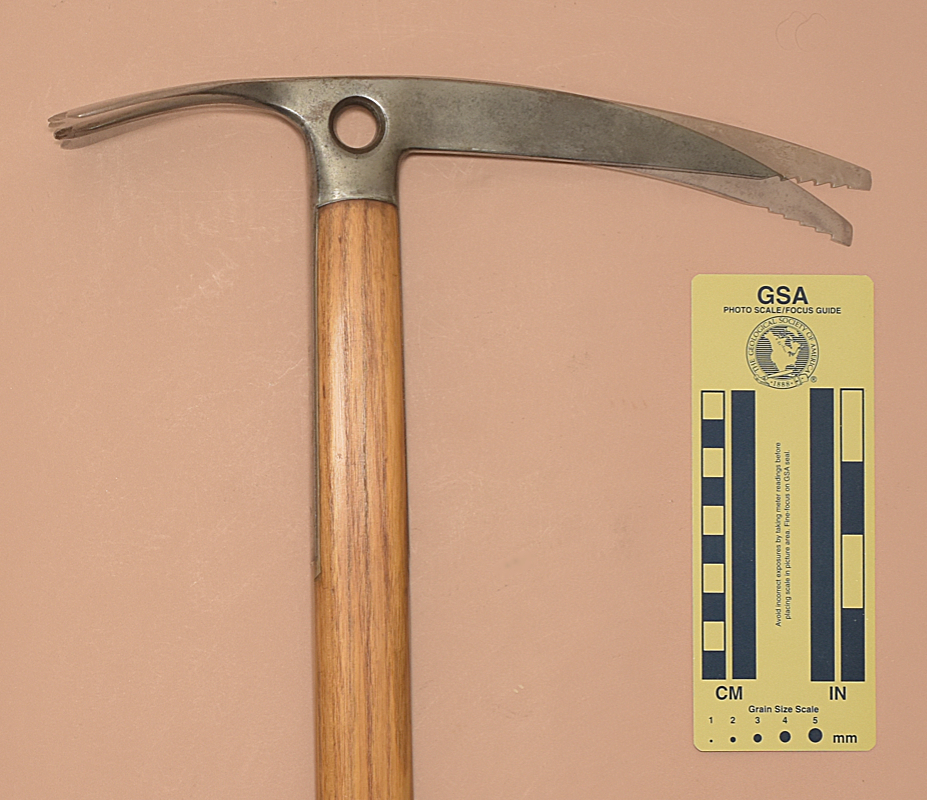In 1897 a group of small ironworks in/around the Fulpmes (Stubai) area banded together to make mountaineering and other items. In 1955, Werkgen Fulpmes changed their name to “Stubai” and subsequently marketed their items under the Stubai brand name.
Ice Axes
Aschenburger
Peter Aschenbrenner was an Austrian Guide who participated in the 1934 and led the 1953 expedition to Nanga Parbat. He developed this ice axe design in the early 1930s.
The Aschenbrenner ice axe was the most successful wood-shafted ice axe of all time. They were widely used until wood shafts went out of fashion.
↑ 138: Stubai Aschenbrenner
- Made in Austria [1960s].
- 85x26 cm.
- Wood Shaft.
- Fixed Head .
- Curved adze with straight edge.
- Straight Alpine pick with a diamond-point tip and with 15 ventral teeth.
- Square spike.
- The glide ring and stop are missing. .
- General purpose mountaineering axe that excels at step cutting.
- The Stubai logo dates this axe to the 1960s.
Nange Parbat
The Nanga Parbat had a straight pick. The Nanga Parbat Extrem had a curved pick and more droop to the adze.

↑ 139: Stubai Nanga Parbat
- Made in Austria [1960s].
- 80x28 cm.
- Wood Shaft.
- Fixed Head with carabiner hole.
- Curved adze with scalloped edge.
- Straight Alpine pick with a positive-clearance chisel tip and with 5 ventral teeth.
- Square spike.
- Glide ring with adjustable web strap.
- This is an earlier wood-shafted, straight pick version of my normal mountaineering axe.
↑ 072: Stubai Nanga Parbat Extrem
- Made in Austria [1960s].
- 75x28 cm.
- Wood Shaft.
- Fixed Head with carabiner hole.
- Drooped adze with scalloped edge.
- Curved Alpine pick with a positive-clearance chisel tip and with 5 ventral teeth.
- Square spike.
- Glide ring with adjustable web strap.
- This is an earlier wood-shafted version of my normal mountaineering axe.
↑ 029: Stubai Nanga Parbat Extrem
- Made in Austria [1976].
- 75x28 cm.
- Fiberglass Shaft.
- Fixed Head with carabiner hole.
- Drooped adze with scalloped edge.
- Curved Alpine pick with a positive-clearance chisel tip and with 5 ventral teeth.
- Square spike.
- I replaced the glide ring and stop with an aftermarket Black Diamond leash.
- This is my normal mountaineering axe, although I wish that I had gotten a slightly longer one. The scalloped adze works well in ice. I reshaped the pick to give it a positive clearance for hard ice. The foam-cored fiberglass shaft does not chill the hands like metal shafts do.
Swiss Military
↑ 153: Stubai Swiss Military
- Made in Austria [1970s].
- 60x28 cm.
- Wood Shaft.
- Fixed Head.
- Adze is strongly curved in both directions.
- Straight Alpine pick with a pointed tip.
- Square spike.
- The adze on this axe has more curvature, both front-to-back and side-to-side, than any other ice axe I've seen.
- This model was used by the Swiss army. Stamped with a Swiss Cross.
Wallner
↑ 158: Stubai Wallner
- 90x27 cm.
- Wood Shaft.
- Fixed Head with carabiner hole.
- Drooped adze strongly curved in both directions with a scalloped edge.
- Straight Alpine pick with a diamond-point tip and with 6 ventral teeth.
- Square spike.
- Glide ring with web strap (loop cut off).
- The scalloped adze works well in ice. The flared diamond-pointed pick fractures the ice well when step cutting.
Tyrol
↑ 036: Stubai Tirol
- Made in Austria.
- 52x23 cm.
- Plastic-covered aluminum shaft.
- Full modular head .
- Tubular adze.
- Modular waterfall ice pick with a neutral-clearance chisel tip and with seven notches near tip then four coarse teeth.
- Triangular spike.
- Equipped with an aftermarket Charlet Moser leash.
- Unique 54 mm. circular adze and Extrem 150 pick for hard ice. Shown with modular hammer face to substitute for the adze, and an unusual substitute spike as well.
![]()
![]()